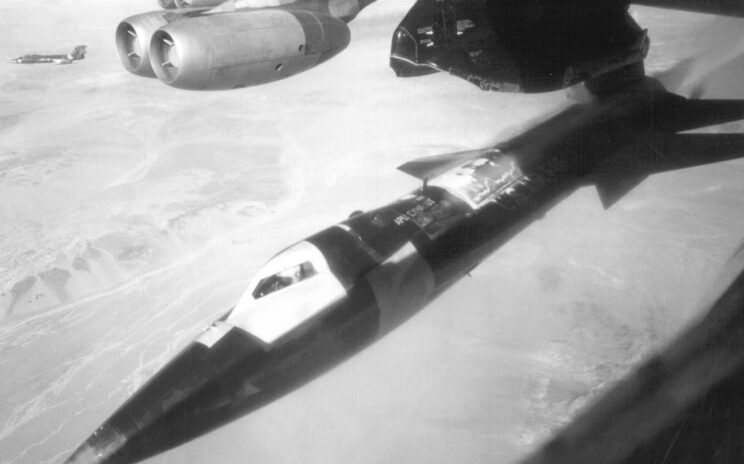Originally shared by +Gazing Skyward TV Aviation June 8th, 1959First un-powered flight of the North American X-15. The North American X-15 was a hypersonic rocket-powered aircraft operated by the United States Air Force and the National Aeronautics and Space Administration as part of the X-plane series of experimental aircraft. The X-15 set speed and altitude records in the 1960s, reaching the edge of outer space and returning with valuable data used in aircraft and spacecraft design. As of 2015, the X-15 holds the official world record for the highest speed ever reached by a manned, powered aircraft. Its maximum speed was 4,520 miles per hour (7,274 km/h), or Mach 6.72. During the X-15 program, 13 flights by eight pilots met the Air Force spaceflight criterion by exceeding the altitude of 50 miles (80 km), thus qualifying the pilots for astronaut status. The Air Force pilots qualified for astronaut wings immediately, while the civilian pilots were awarded NASA astronaut wings in 2005, 35 years after the last X-15 flight. The sole Navy pilot in the X-15 program never took the aircraft above the requisite 50 mile altitude. Of all the X-15 missions, two flights (by the same pilot) qualified as space […]
NASA recently released a 1.5 billion pixel image of the Andromeda galaxy, our nearest galactic neighbor, which contains over 100 million stars and spans more than 40,000 light years – and that’s just a section of the galaxy. This image, created from a mosaic of 411 Hubble pictures, was then used by YouTuber daveachuk to create this incredible fly-through video. Combined with gorgeous music from the band Koda, it’s an awe-inspiring – and humbling – experience. #nasa #hubblespacetelescope
Reshared post from +NASA As seen on #Cosmos: Supernova A supernova is the explosion of a star. It is the largest explosion that takes place in space. Supernovas are often seen in other galaxies. But supernovas are difficult to see in our own Milky Way galaxy because dust blocks our view. In 1604, Johannes Kepler discovered the last observed supernova in the Milky Way. NASA’s Chandra telescope discovered the remains of a more recent supernova. It exploded in the Milky Way more than a hundred years ago. A supernova happens where there is a change in the core, or center, of a star. A change can occur in two different ways, with both resulting in a supernova. The first type of supernova happens in binary star systems. Binary stars are two stars that orbit the same point. One of the stars, a carbon-oxygen white dwarf, steals matter from its companion star. Eventually, the white dwarf accumulates too much matter. Having too much matter causes the star to explode, resulting in a supernova. The second type of supernova occurs at the end of a single star’s lifetime. As the star runs out of nuclear fuel, some of its mass flows into […]
This is what my neck feels like tonight…. Originally shared by +NASA As seen on #Cosmos: Supernova A supernova is the explosion of a star. It is the largest explosion that takes place in space. Supernovas are often seen in other galaxies. But supernovas are difficult to see in our own Milky Way galaxy because dust blocks our view. In 1604, Johannes Kepler discovered the last observed supernova in the Milky Way. NASA’s Chandra telescope discovered the remains of a more recent supernova. It exploded in the Milky Way more than a hundred years ago. A supernova happens where there is a change in the core, or center, of a star. A change can occur in two different ways, with both resulting in a supernova. The first type of supernova happens in binary star systems. Binary stars are two stars that orbit the same point. One of the stars, a carbon-oxygen white dwarf, steals matter from its companion star. Eventually, the white dwarf accumulates too much matter. Having too much matter causes the star to explode, resulting in a supernova. The second type of supernova occurs at the end of a single star’s lifetime. As the star runs out of […]


